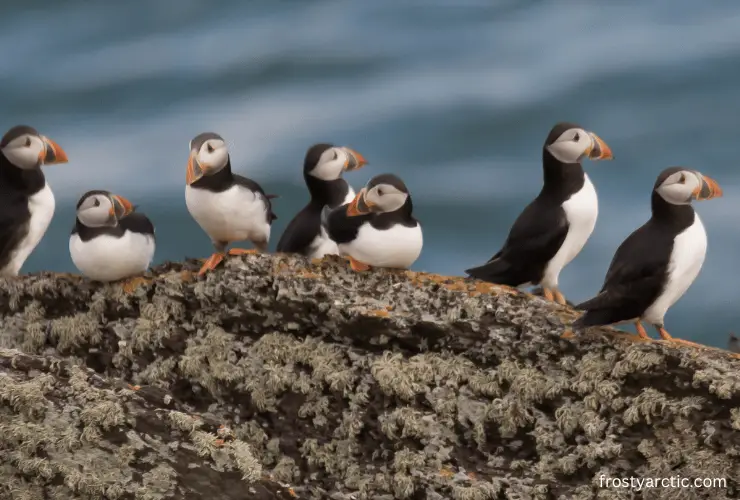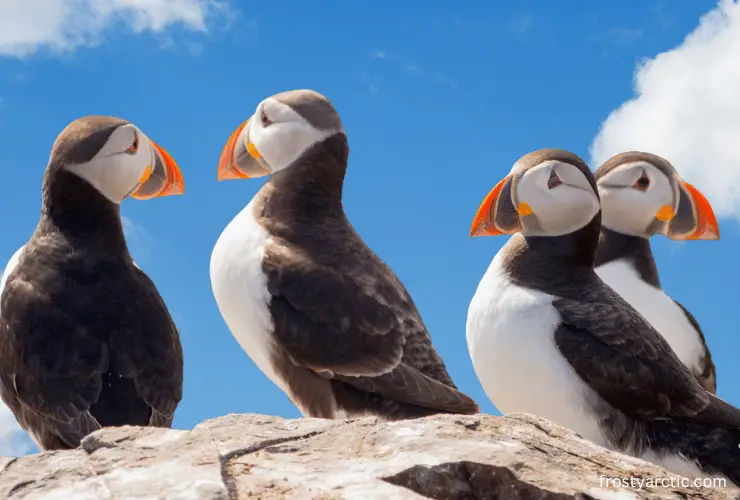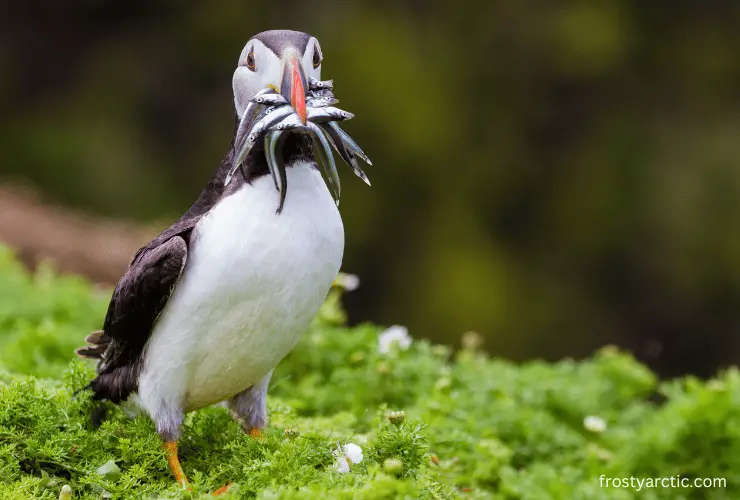Puffins mainly dine on a seafood menu, especially small fish such as sand eels, herring, and capelin. Their diet varies with season, availability, and location, but fish remains the staple component. However, they do not limit themselves to fish, supplementing their diet with invertebrates like squid and zooplankton.
But what do puffins eat the most? Puffins, with their colorful beaks and waddling gait, are carnivores that prefer a fish-based diet. But the fascinating world of puffin food isn’t confined just to fish.
They are opportunistic feeders, meaning they’ll eat what’s available, which can include an array of other sea creatures. This variety helps puffins adapt to the changing seascape, ensuring their survival in different conditions. So, let’s dive in to understand more about the preferred food choices of these intriguing birds.
Are Puffins a Carnivore or Herbivore?
To fully understand puffins’ eating habits, we must first know whether they are carnivores, herbivores, or somewhere in between. A carnivore is an animal that mainly consumes meat, whereas a herbivore is an animal that consumes plants. So where do puffins fit in this range? Let’s explore.
Puffins: The Carnivorous Sea Birds
As per the findings of the AZA Charadriiformes Taxon Advisory Group, puffins are indeed carnivorous. They thrive primarily on a seafood diet, devouring small fish. Their meat-eating habits place them firmly in the category of carnivores.
However, puffins are not strictly carnivorous like lions or eagles. They are described as opportunistic carnivores. This means that although they prefer meat, they’ll consume other food items if the opportunity arises, mainly if their favored food sources are scarce.
This adaptable nature of puffins’ diet is a survival trait that allows them to endure the unpredictable conditions of the ocean. For example, when their usual prey, small fish, becomes scarce due to changes in sea temperature or overfishing, puffins can switch their diet to marine invertebrates such as squid and crustaceans, as a study by the Marine Ecology Progress Series suggests.
What is Puffin’s Favorite Food?
Puffins are synonymous with the image of carrying multiple fish in their beaks, a testament to their preferred meal. Scientific research, such as that by The Birds of North America Online, has established that puffins’ favorite food consists of small fish species. These typically include
- Sand eels
- Small cod
- Herring
- Hake
- Pollock
- Anchovy
- Sprats
- Northern smooth tongue
- Capelin
- Lanternfishes.
Why Small Fish?

Puffins prefer small fish for several reasons. Firstly, their size makes these fish manageable for puffins to catch, carry, and eat. Secondly, these fish are abundant in the waters puffins inhabit, making them an easily accessible and reliable food source.
Sand Eels: The Puffin’s Favorite Food
Sand eels (also known as sand lances) are a favorite of all the fish that puffins consume. The abundance and nutritional richness of sand eels make them an ideal food source for puffins.
According to an article published in Bird Study, the energy-rich sand eels contribute significantly to the puffin’s dietary needs, enabling them to maintain their energy levels and ensure their survival in their demanding marine environment.
Herring and Capelin: Nutritious Alternatives
In addition to sand eels, puffins also enjoy herring and capelin. These fish species are essential during breeding season, when puffins require more energy.
They are rich in fats and nutrients, which are necessary for puffins to maintain their health and rear their pufflings, as confirmed by studies in the Encyclopedia of Ocean Sciences.
These fish are abundant in the North Atlantic and Arctic Oceans, the primary habitats of puffins.
What Do Puffins Eat Other than Fish?
Although small fish are a staple in a puffin’s diet, these seabirds exhibit impressive dietary adaptability. They can, and often do, extend their menu beyond fish, incorporating a variety of marine invertebrates.
Invertebrates
According to Animal Diversity, puffins supplement their fish-rich diet with marine invertebrates. This can include mollusks and aquatic or marine worms. These invertebrates provide a good alternative food source, especially during times when fish populations may be lower due to environmental changes or overfishing.
Cephalopods

Beyond fish and invertebrates, cephalopods, such as squids and octopuses, are also on the puffin’s menu. Though less common than fish in their diet, puffins do squid and octopus. They provide valuable nutrients and can be easier to catch when they come up to the sea surface at night.
Crustaceans
Shrimp and other small crustaceans also form part of the puffin’s diet. They are especially important for young puffins, who may find them easier to eat compared to fish. Additionally, crustaceans such as amphipods can become a significant food source when fish are scarce.
Jellyfish and Zooplankton
When times are tough, puffins have been known to consume jellyfish and zooplankton, as U.S. Fish & Wildlife Service reported. Although they aren’t the puffins’ first choice, these organisms offer some nutritional value. They are easier to catch, making them viable options when other preferred foods are in short supply.
What Do Baby Puffins Eat?
Baby puffins, affectionately known as pufflings, are fed a diet that closely mirrors that of their parents. After hatching, pufflings are entirely dependent on their parents for food. But what exactly do these fluffy youngsters eat?
Fish
Just like adult puffins, pufflings primarily eat fish. According to a study in Ecology, parents catch and bring small fish back to the nest to feed their young. This includes their favorite sand eels, as well as herring and capelin.
The size of the fish that puffin parents catch for their pufflings is important. The Scottish Seabird Centre notes that parents typically choose smaller fish for their young, as they are easier for the pufflings to swallow. The fish are delivered to the pufflings whole, so smaller fish are a safer and more manageable meal for these tiny birds.
Marine Invertebrates
In addition to fish, pufflings also eat marine invertebrates. This part of their diet might include crustaceans like shrimp, mainly when fish are less available. This supplementation helps ensure the pufflings receive a variety of nutrients essential for their growth and development.
How Often Do Puffins Eat?

Puffins, like most wild creatures, do not follow rigid feeding schedules as we humans do. Instead, their eating schedule and the amount they consume are influenced by a variety of factors, including the availability of food, the time of year, and whether they are feeding chicks. But just how often do puffins eat, and how much do they consume?
According to ScienceDaily, puffins usually feed several times a day. During the breeding season, adult puffins may catch and carry up to 10 fish at a time back to their nest for their pufflings.
Outside of the breeding season, the frequency of puffin meals depends mainly on food availability and energy needs. Puffins may consume a substantial number of fish in one feeding session and then spend a few hours resting and digesting before their next meal.
How Much Do Puffins Eat?
As for the amount of food puffins eat, it can vary widely. A puffin’s diet is primarily composed of small fish, and an individual puffin can eat anywhere from 10 to 60 fish per day, as per the National Audubon Society. So, they make a few daily trips to the sea to satisfy their bellies.
Did you know little pufflings eat more than their parents? They have been observed eating up to 100 fish in a day.
Seasonal Variations in the Diet of Puffins
Puffins, like many species, have diets that can vary significantly with the changing seasons, which in turn, influence the availability of food sources.
Spring: The Breeding Season Begins
As spring arrives and puffins return to their breeding colonies, their diet primarily consists of small fish. According to a study published in the Encyclopedia of Ocean Sciences, the availability of their favorite food, the sand eel, tends to peak during this season.
Sand eels are an excellent source of nutrients, helping puffins replenish their energy reserves after the winter and prepare for the upcoming breeding season.
Summer: Feeding the Pufflings
In summer, the availability of sand eels and other small fish remains high. This is crucial as it is the time when pufflings hatch and require frequent feeding. The parents catch and carry several small fish at a time in their beaks back to the nest, ensuring their young get the nutrients they need for rapid growth.
Autumn: Preparing for Winter
As autumn sets in and the breeding season ends, puffins begin to prepare for winter. Puffins at this time may consume a higher proportion of energy-rich foods like squid and larger fish, building up their fat reserves for the winter months when food becomes scarcer.
Winter: Scarcity and Survival
During winter, puffins spend their time at sea, and food sources become less abundant. During these months, research shows that puffins may have to rely more heavily on available marine invertebrates, such as shrimp and crabs. This shift in diet reflects the puffins’ adaptability to changing food availability and the challenging conditions of the winter months.
How Do Puffins Eat?

Puffins are expert hunters. Their unique physical traits and behaviors allow them to hunt efficiently in their marine environment. But what techniques do they use, and how exactly do puffins eat their prey? Let’s discover.
Plunge Diving
Puffins employ a hunting technique known as plunge diving. According to a study published in The Auk, these seabirds can dive to depths of up to 60 meters, propelling themselves underwater with strong wingbeats and steering with their rudder-like webbed feet. This skillful maneuvering allows them to pursue and catch fish with their sharp, hooked beaks.
Multiple Prey Loading
Did you know puffins can hold multiple fish in their beaks simultaneously?
The National Museum of Scotland reveals that this is possible due to the puffin’s unique hinged upper jaw and the rough, tongue-like structure on the roof of their mouth, which helps them grip the slippery bodies of the fish. This ability means a puffin can catch and carry up to 20 fish (although up to 60 have been seen) at a time, maximizing the rewards of each hunting trip.
Eating On the Go
Once puffins have captured their prey, they typically eat while still at sea. As National Geographic documented, puffins can often be seen floating on the water’s surface, tossing a captured fish in the air and then catching it in their beak to swallow it head-first. This method ensures the fish’s scales and fins don’t irritate the puffin’s throat.
Feeding the Pufflings
During the breeding season, the hunted fish are taken back to the nest to feed their pufflings. Parent puffins transfer the fish to their young, who swallow the meal whole.
FAQs
Q: Does a puffin have teeth?
A: Puffins don’t have teeth like mammals. They have backward-facing, tooth-like serrations on their beaks and tongues that help grip their slippery prey.
Q: Do puffins eat crabs?
A: Puffins may occasionally eat small crabs, as their diet extends beyond fish to include various marine invertebrates, especially when their preferred fish are scarce.
Q: Do puffins eat worms?
A: While puffins primarily feed on small fish and invertebrates, they might ingest marine worms, although this isn’t a significant part of their diet.
Q: Do puffins eat fruit?
A: Puffins do not eat fruit. Their diet is focused on marine food sources such as small fish and invertebrates, and their digestive systems aren’t adapted to process plant material.
Q: Do puffins eat salmon?
A: Puffins can occasionally eat small or juvenile salmon if readily available. However, salmon only make up a small part of their diet because they are larger than the puffin’s preferred prey.
Q: Do puffins eat plants?
A: No, puffins do not typically consume plants. Like many other seabirds, they do not have a digestive system that’s equipped to process plant material. Their beaks and digestive systems are specifically designed to catch, hold and digest marine animals, which provide the necessary nutrients these birds need to survive in their oceanic environment.
Wrapping Up
So, what do puffins eat? Puffins are skilled fishermen. Their diet comprises several types of small fish, particularly sand eels, herring, and capelin. They also supplement their diet with marine invertebrates like squid and crustaceans. These choices provide them with the necessary nutrients to sustain their high-energy lifestyle.
Young puffins are initially fed small crustaceans but gradually transition to a diet similar to that of adults. The puffin’s exceptional hunting skills and unique ability to grip several fish in their beak at once are critical factors for their sustenance and survival. The complex, adaptive diet of puffins thus mirrors their dynamic and energetic existence amidst the vast ocean waves.



1 thought on “What Do Puffins Eat? [Complete Diet of Puffin] ”